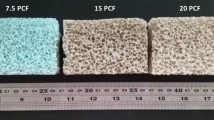Abstract
Purpose
Our objective was to evaluate the dynamic time window method (DTWM) for the measurement of speed of sound (SOS) at the 1/3 distal radius in 10 human subjects in vivo. DTWM, which is based on our proprietary probe, is a new method for obtaining the accurate time of flight (TOF) of the first arriving signal (FAS).
Method
This study compared DTWM with three conventional methods, i.e., threshold value method, first of maxima, and zero-crossing method, for the measurement of TOF of FAS.
Results
The highest correlation between SOS and bone mineral density (BMD) was found in the 10 human subjects using DTWM (R DTWM = 0.81, p < 0.005) rather than the three conventional methods (R = 0.37–0.41, p > 0.05). The individual short-term coefficient of variation (CV, from 0.07 to 0.27) and Root-Mean-Square (RMS) of the average CV (CVRMS, 0.18) were used to evaluate the reproducibility of our method (DTWM).
Conclusion
Despite the small population, the results suggest that DTWM improves the accuracy of recognition of SOS in vivo, and might be applied to optimize the clinical assessment of long cortical bone osteoporosis and fracture risk profile.







Similar content being viewed by others
References
Talmant M, Kolta S, Roux C, et al. In vivo performance evaluation of bi-directional ultrasonic axial transmission for cortical bone assessment. Ultrasound Med Biol. 2009;35:912–9.
Protopappas VC, Vavva MG, Fotiadis DI, et al. Ultrasonic monitoring of bone fracture healing. IEEE Trans UFFC. 2008;55:1243–55.
Sasso M, Talmant M, Haiat G, et al. Analysis of the most energetic late arrival in axially transmitted signals in cortical bone. IEEE Trans UFFC. 2009;56:2463–70.
Daugschies M, Rohde K, Gluer CC, et al. The preliminary evaluation of a 1 MHz ultrasound probe for measuring the elastic anisotropy of human cortical bone. Ultrasonics. 2014;54:4–10.
Barbieri G, Barbieri CH, Mazzer N, et al. Ultrasound propagation velocity and broadband attenuation can help evaluate the healing process of an experimental fracture. J Orthop Res. 2011;29:444–51.
Foiret J, Grimal Q, Talmant M, Longo R, et al. Probing heterogeneity of cortical bone with ultrasound axial transmission. IEEE Trans UFFC. 2013;60:187–93.
Muller M, Moilanen P, Bossy E, et al. Comparison of three ultrasonic axial transmission methods for bone assessment. Ultrasound Med Biol. 2005;31:633–42.
Protopappas VC, Fotiadis DI, Malizos KN. Guided ultrasound wave propagation in intact and healing long bones. Ultrasound Med Biol. 2006;32:693–708.
Machado CB, Albuquerque Pereira WC, Talmant M, et al. Computational evaluation of the compositional factors in fracture healing affecting ultrasound axial transmission measurements. Ultrasound Med Biol. 2010;36:1314–26.
Protopappas VC, Dimitrios AB, Likas AC, et al. An ultrasound wearable system for the monitoring and acceleration of fracture healing in long bones. IEEE T Bio Med Eng. 2005;52:1597–608.
Grondin J, Grimal Q, Engelke K, et al. Potential of first arriving signal to assess cortical bone geometry at the hip with QUS: a model based study. Ultrasound Med Biol. 2010;36:656–66.
Bossy E, Talmant M, Laugier P. Effect of bone cortical thickness on velocity measurements using ultrasonic axial transmission: a 2D simulation study. J Acoust Soc Am. 2002;112:297.
Dodd SP, Cunningham JL, Miles AW, et al. Ultrasound transmission loss across transverse and oblique bone fractures: an in vitro study. Ultrasound Med Biol. 2008;34:454–62.
Bossy E, Talmant M, Defontaine M, et al. Bidirectional axial transmission can improve accuracy and precision of ultrasonic velocity measurement in cortical bone: a validation on test materials. IEEE Trans UFFC. 2004;51:71–9.
Barkmann R, Kantorovich E, Singal C, et al. A new method for quantitative ultrasound measurements at multiple skeletal sites. J Clin Densitom. 2000;3:1–7.
Kantorovich E, Pasternak V, Ashkenazi S, et al. Determination of acoustic velocity in bone. US Patent 7, 2006;112:173 B1.
Bossy E, Talmant M, Peyrin F, et al. An in vitro study of the ultrasonic axial transmission technique at the radius: 1-MHz velocity measurements are sensitive to both mineralization and intracortical porosity. J Bone Miner Res. 2004;19:1548–56.
Laugier P, Haiat G. Bone quantitative ultrasound. Dordrecht: Springer; 2011.
Klippa V. Osteoporos Int. 2011;22:1103.
Kilappa V, Xu KL, Moilanen P, et al. Assessment of the fundamental flexural guided wave in cortical bone by an ultrasonic axial-transmission array transducer. Ultrasound Med Biol. 2013;39:1223–32.
Vavva MG, Protopappas VC, Gergidis LN, et al. The effect of boundary conditions on guided wave propagation in two-dimensional models of healing bone. Ultrasonics. 2008;48:598–606.
Baron C. Using the gradient of human cortical bone properties to determine age-related bone changes via ultrasonic guided waves. Ultrasound Med Biol. 2012;38:972–81.
Song X, Ta D, Wang W. Analysis of superimposed ultrasonic guided waves in long bones by the joint approximate diagonalization of eigen-matrices algorithm. Ultrasound Med Biol. 2011;37:1704–13.
Hans D, Srivastav SK, Singal C, et al. Does combining the results from multiple bone sites measured by a new quantitative ultrasound device improve discrimination of hip fracture? J Bone Miner Res. 1999;14:644–51.
Acknowledgments
This work was supported by the NSFC (No. 61401436), the National Science and Technology Pillar Program (No. 2013BAH14F01), and the Natural Science Foundation of Anhui Province of China (No. 1308085MF99).
Author information
Authors and Affiliations
Corresponding author
Ethics declarations
Conflict of interest
There are no financial or other relations that could lead to a conflict of interest.
Ethical statements
The study was approved by the local Institutional Review Board. All study participants gave written informed consent after the study was explained to them.
About this article
Cite this article
Xu, Y., Xu, Y., Chen, Y. et al. Quantitative ultrasound measurement of bone density based on dynamic time window: suitable for the measurement of speed of sound in radius. J Med Ultrasonics 43, 347–354 (2016). https://doi.org/10.1007/s10396-016-0710-4
Received:
Accepted:
Published:
Issue Date:
DOI: https://doi.org/10.1007/s10396-016-0710-4




